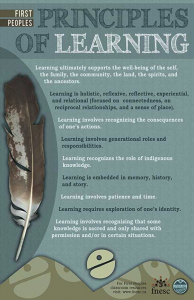Throughout my 491 practicum I had the chance to grow my practice around the ideas summarized by the first people principles of learning. I believe that these principles are vital to growing as a teacher and growing in my ability to connect with all students and to help them build connections with the world around them. During this practicum I had the chance to show students a tool created by BC educators called BC Tomorrow that uses environmental modeling software to examine the connections between human land use and environmental and socioeconomic indicators that allows students to look at the past, present, and future of their local watershed to explore these connections and use their own decision making and planning to change possible future outcomes. The purpose of this activity was to give students a learning opportunity that was holistic, reflexive, reflective, experiential, and relational while being focused on connectedness, reciprocal relationships, and a sense of place (First Peoples Principle of Learning #2). I believe that this principle is intricately linked to all the First Peoples Principles of Learning as they are all connected and are all important for a holistic approach to education.
I also feel that the UNBC School of Education’s signature pedagogy of “People, Place, and Land” also speaks to this connectedness of all. All three are focuses of our school where we want to place a value on People, who have strong connections to Place, and are a product of, and stewards of, Land. I also believe that this signature pedagogy is significant in the connections that it implies between the three. People, Place, and Land are intricately interconnected, and all have profound effects on one another, where one cannot move without affecting another, and cannot exist without the others.
One model that I like to use to think about the connectedness of life and this earth is the metaphor of a watershed in relation to a student and their environment. Where the water entering a watershed is affected by the weather of the planet and the conditions of the watersheds around them, just as a student is a product of their surroundings and their interactions with the world around them. The condition and output of a watershed in turn influences the surrounding environment in that its condition determines the quality of the water leaving it as well as how it functions as a habitat and how it contributes to the environment through processes such as transpiration, photosynthesis, and other processes. A student also takes the input they receive and make choices that influence the world around them including their community and environment. Just like a watershed we are part of an interconnected system that has relationships everywhere we look.

Links:
First Peoples Principles of Learning – Poster – from FNESC
http://www.fnesc.ca/wp/wp-content/uploads/2015/09/PUB-LFP-POSTER-Principles-of-Learning-First-Peoples-poster-11×17.pdf
First Peoples Principles of Learning – Blog – by Jo Chrona from FNESC
https://firstpeoplesprinciplesoflearning.wordpress.com/
Learning First Peoples Classroom Resources – from FNESC
http://www.fnesc.ca/learningfirstpeoples/

